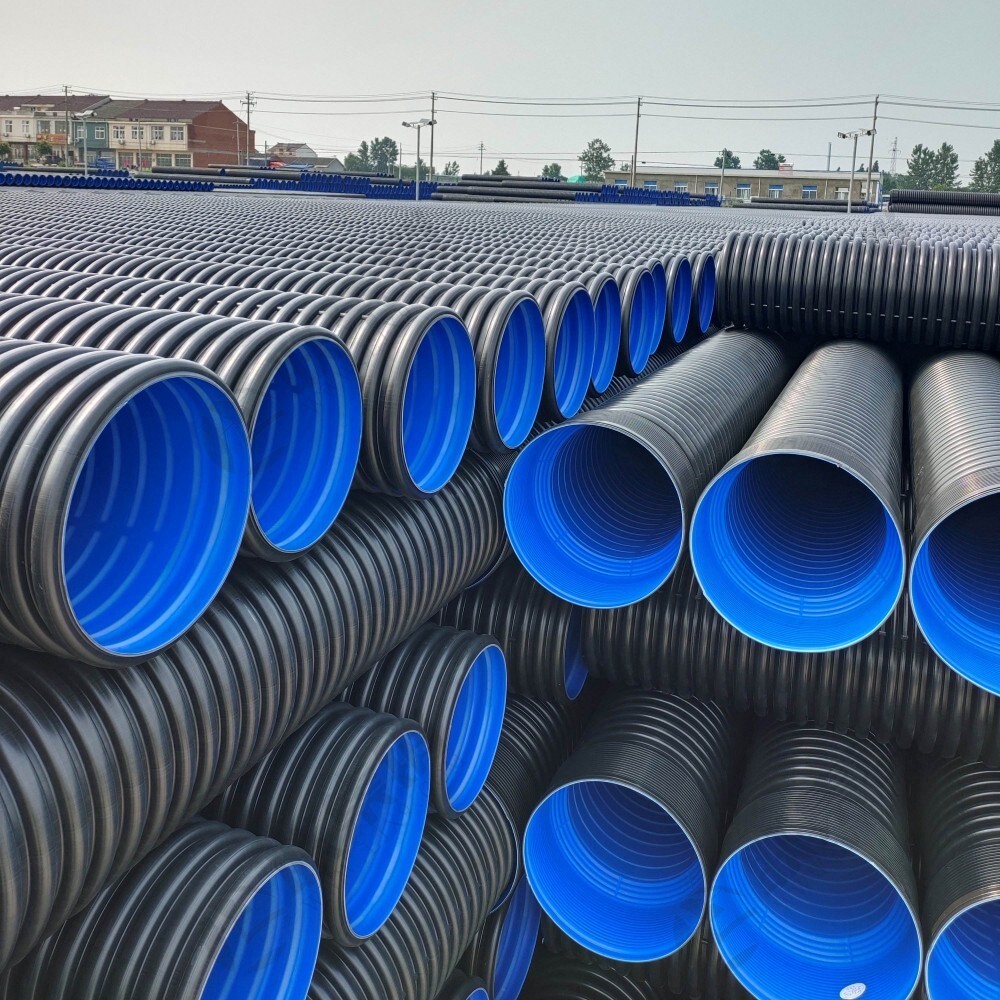- Advantages of using PE double-wall corrugated pipe
 High-density polyethylene (HDPE) double-wall corrugated pipe, is a new type of pipe with a ring-like structure of the outer wall and smooth inner wall, was first successfully developed in Germany in the early 80s. After more than a decade of development and improvement, it has been developed from a single species to a complete series of products. In the production process and the use of technology has been very mature. Because of its excellent performance and relatively economic cost, in Europe and the United States and other developed countries have been greatly promoted and applied. In China, the promotion and application of HDPE double-wall corrugated pipe is in a rising trend stage, the technical indicators have reached the use of standards. Double-wall corrugated pipe inner wall color is usually blue and black, some brands will use yellow inner wall. 15Learn more
High-density polyethylene (HDPE) double-wall corrugated pipe, is a new type of pipe with a ring-like structure of the outer wall and smooth inner wall, was first successfully developed in Germany in the early 80s. After more than a decade of development and improvement, it has been developed from a single species to a complete series of products. In the production process and the use of technology has been very mature. Because of its excellent performance and relatively economic cost, in Europe and the United States and other developed countries have been greatly promoted and applied. In China, the promotion and application of HDPE double-wall corrugated pipe is in a rising trend stage, the technical indicators have reached the use of standards. Double-wall corrugated pipe inner wall color is usually blue and black, some brands will use yellow inner wall. 15Learn more - Advantages of using plastic inspection wells
 Plastic inspection wells, commonly known as plastic "manholes", are set up in plastic drainage pipe intersections, turns, changes in pipe diameter or slope, waterfalls, or straight pipeline segments at certain intervals, to facilitate regular inspection, cleaning, and dredging of the pipeline drainage accessory structures. Plastic inspection wells are mostly one-time injection molding, with reducer joints, angle joints and rubber seals and other accessories to achieve the change of pipe diameter and angle of the connection. Plastic inspection wells supporting the development of the cover, well and related accessories, road load through the cover, well seat around the role of the inspection wells, to avoid damage to the road load on the inspection wells. The well seat has the function of floating up and down, which can actively adapt to the changes in the height of the road surface. Meanwhile, the well barrel adopts the special well barrel, which can intercept the corresponding length according to the burial depth at the site, which is flexible and convenient. The connection between the shaft, water inlet (outlet) pipe and well base adopts rubber sealing ring flexible socket connection or heat-shrinkable sleeve connection, which can be adapted to a small range of angular changes, convenient and quick construction, good sealing performance, leakage prevention, effective prevention of secondary pollution of groundwater, and is a kind of environmentally friendly and energy-saving building materials. Plastic inspection wells can be divided into rainwater plastic inspection wells and sewage plastic inspection wells according to the use of plastic inspection wells, the application field is divided into building community drainage plastic inspection wells and municipal drainage plastic inspection wells. 15Learn more
Plastic inspection wells, commonly known as plastic "manholes", are set up in plastic drainage pipe intersections, turns, changes in pipe diameter or slope, waterfalls, or straight pipeline segments at certain intervals, to facilitate regular inspection, cleaning, and dredging of the pipeline drainage accessory structures. Plastic inspection wells are mostly one-time injection molding, with reducer joints, angle joints and rubber seals and other accessories to achieve the change of pipe diameter and angle of the connection. Plastic inspection wells supporting the development of the cover, well and related accessories, road load through the cover, well seat around the role of the inspection wells, to avoid damage to the road load on the inspection wells. The well seat has the function of floating up and down, which can actively adapt to the changes in the height of the road surface. Meanwhile, the well barrel adopts the special well barrel, which can intercept the corresponding length according to the burial depth at the site, which is flexible and convenient. The connection between the shaft, water inlet (outlet) pipe and well base adopts rubber sealing ring flexible socket connection or heat-shrinkable sleeve connection, which can be adapted to a small range of angular changes, convenient and quick construction, good sealing performance, leakage prevention, effective prevention of secondary pollution of groundwater, and is a kind of environmentally friendly and energy-saving building materials. Plastic inspection wells can be divided into rainwater plastic inspection wells and sewage plastic inspection wells according to the use of plastic inspection wells, the application field is divided into building community drainage plastic inspection wells and municipal drainage plastic inspection wells. 15Learn more
{item.title}

{item.description}
15
Learn more
Product Center
Leave a message online



